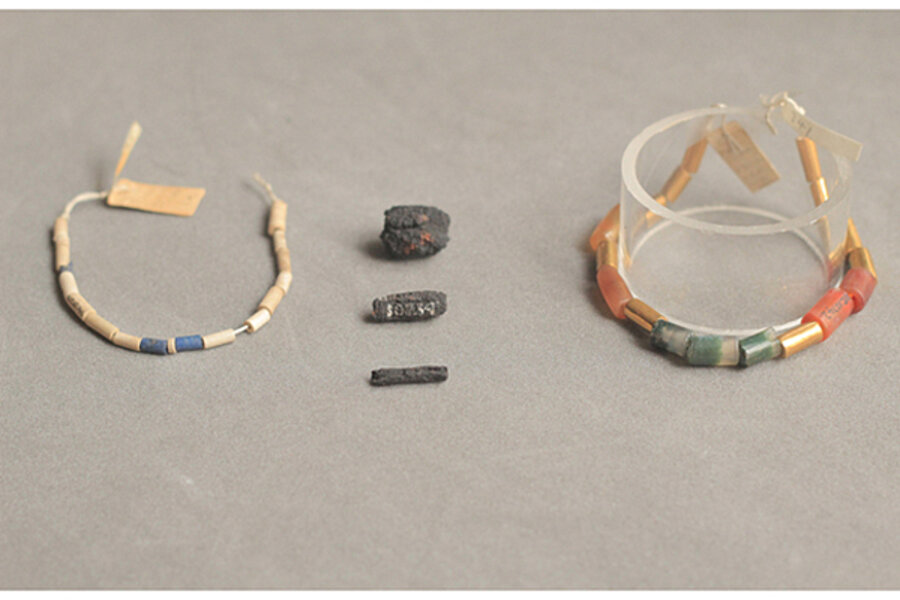Ancient Egyptian jewelry came from outer space, say scientists
Ancient Egyptian beads found in a 5,000-year-old tomb were made from iron meteorites that fell to Earth from space, according to a new study. The beads, which are the oldest known iron artifacts in the world, were crafted roughly 2,000 years before Egypt's Iron Age.
In 1911, nine tube-shaped beads were excavated from an ancient cemetery near the village of el-Gerzeh, which is located south of Cairo, said study lead author Thilo Rehren, a professor at UCL Qatar, a Western Asian outpost of the University College London's Institute of Archaeology. The tomb dates back to approximately 3200 B.C., the researchers said.
Inside the tomb, which belonged to a teenage boy, the iron beads were strung together into a necklace alongside other exotic materials, including gold and gemstones. Early tests of the beads' composition revealed curiously high concentrations of nickel, a telltale signature of iron meteorites. [See Photos of the Egyptian Beads & Other Meteorite Jewels]
"Even 100 years ago, [the beads] attracted attention as being something strange," Rehren told LiveScience.
But without definitive proof of the beads' cosmic origins, questions persisted over whether similar amounts of nickel could be present in human-made iron. By scanning the iron beads with beams of neutrons and gamma rays, the researchers found high concentrations of cobalt, phosphorous and germanium; these elements were present at levels that only occur in iron meteorites.
"It's really exciting, because we were able to detect sufficient cobalt and germanium in these beads to confirm they're meteoritic," Rehren said. "We had assumed this was the case for 100 years, but it's nice to be able to put an exclamation mark on the label, rather than a question mark."
The X-ray technology also revealed that the beads had been hammered into thin sheets before being meticulously rolled into tubes.
"This meteoritic iron, it's very hard material that you find in lumps, and yet here we see it in thin beads," Rehren said. "The real question is, how were they made?"
Unlike softer and more pliable metals like gold and copper, working with solid iron required the invention of blacksmithing, which involves repeatedly heating metals to red-hot temperatures and hammering them into shape.
"It's a much more elaborate operation and one that we assumed was only invented and developed in the Iron Age, which started maybe 3,000 years ago — not 5,000 years ago," Rehren said.
The researchers suggest the iron meteorites were heated and hammered into thin sheets, and then woven around wooden sticks to create 0.8-inch-long (2 centimeters), tube-shaped beads. Other stones found in the same tomb displayed more traditional stone-working techniques, such as carving and drilling.
"This shows that these people, at this early age, were capable of blacksmithing," Rehren said. "It shows a pretty advanced skill with this difficult material. It might not have been on large scales, but by the time of the Iron Age, they had about 2,000 years of experience working with meteoritic iron."
This is not the first time beads from this Egyptian tomb have been linked to the cosmos. Earlier this year, in May, researchers at the Open University and University of Manchester published a paper in the journal Meteoritics and Planetary Science about the celestial origins of the ancient beads.
Other researchers have identified different artifacts that also have space origins. Last year, German scientists discovered a Buddha statue that was carved from a meteorite between the eighth and 10th centuries.
The detailed findings of the new study were published online today (Aug. 19) in the Journal of Archaeological Science.
Follow Denise Chow on Twitter @denisechow. Follow LiveScience @livescience, Facebook & Google+. Original article on LiveScience.
- Fallen Stars: A Gallery of Famous Meteorites
- Space-y Tales: The 5 Strangest Meteorites
- Shine On: Photos of Dazzling Mineral Specimens
Copyright 2013 LiveScience, a TechMediaNetwork company. All rights reserved. This material may not be published, broadcast, rewritten or redistributed.





